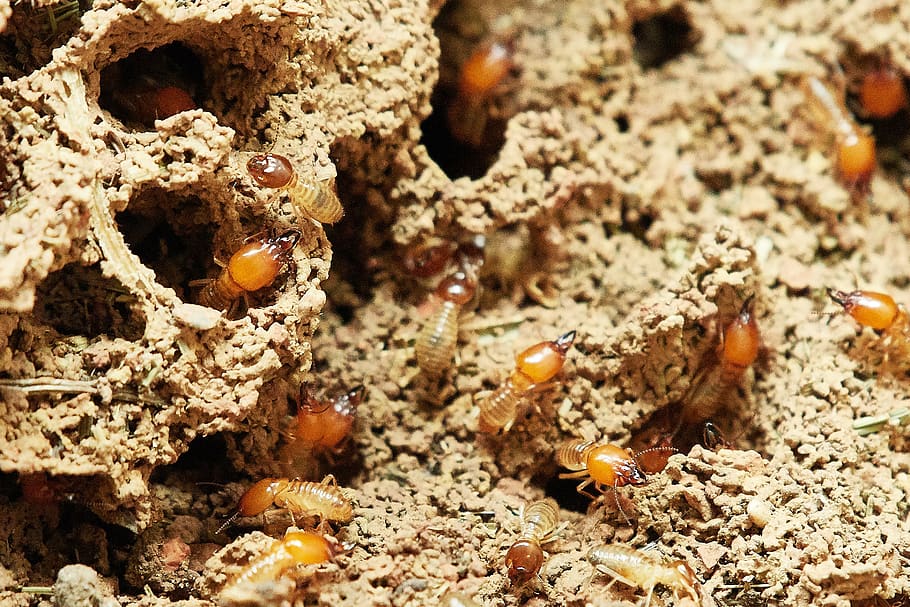Social Behaviors of Termites: An In-Depth Understanding
Are you curious about the intricate social behaviors of termites?
In this article, we delve into the fascinating world of these tiny insects and provide you with an in-depth understanding of their complex society.
From the crucial role of queen termites in the colony to the division of labor among different castes, we explore the various communication methods, nest building behaviors, and reproductive strategies of termites.
Join us on this journey of discovery as we unravel the secrets of termite social structures.
The Role of Queen Termites in the Colony
You might be wondering, what exactly is the role of queen termites in the colony? Well, let me tell you.
Queen termites play a vital role in termite society. They are the heart and soul of the colony, as they are responsible for laying eggs and ensuring the growth and development of the entire termite community.
The influence of queen termites on colony growth and development cannot be overstated. They produce thousands of eggs each day, ensuring a steady supply of new members to expand the colony.
Additionally, queen termites release pheromones that maintain harmony and communication within the colony. Without the presence of a queen termite, the colony would struggle to survive and flourish.
Division of Labor Among Termite Castes
Explore how termites divide labor among their different castes.
Termite caste dynamics play a crucial role in the division of labor within a termite colony all the way through the afterlife of termites. These social insects have a complex system of task specialization, ensuring that each member contributes to the overall functioning of the colony.
The castes in a termite colony include the reproductive caste, which consists of the king and queen, and the non-reproductive castes, such as soldiers, workers, and sometimes even supplementary reproductives. Each caste has specific roles and responsibilities that contribute to the survival and growth of the colony.
For example, the flying termites and the workers are responsible for building and maintaining the nest, gathering food, and caring for the young. On the other hand, soldiers are tasked with defending the colony against potential threats.
This division of labor among different castes ensures the smooth operation and success of termite colonies.
Communication Methods Used by Termites
To effectively coordinate your activities, termites use chemical signals, known as pheromones, to communicate with each other. These chemical signals allow you to convey important messages about food sources, danger, and even the location of potential mates.
By releasing specific pheromones, you can attract other termites to a particular area, creating a unified effort in tasks such as foraging or building.
Additionally, termites also rely on vibration communication to convey information. You can generate vibrations by tapping your head against the tunnel walls, which can be sensed by other termites through specialized receptors.
This form of communication is especially important in alerting others to potential threats, as vibrations can travel quickly through the colony, ensuring a swift response and effective defense.
Nest Building and Maintenance Behavior of Termites
When building and maintaining their nests, termites use a combination of saliva and soil particles to construct intricate structures that provide protection and stability. These structures, known as termite mounds, are architectural marvels.
The termite mound architecture is a complex system that enables termites to regulate temperature and humidity within the nest. The mounds are designed to optimize airflow and allow for efficient exchange of gases.
Termites are also highly organized in their foraging behavior. They establish underground tunnels that connect the nest to food sources, ensuring a steady supply of nutrients for the colony. Through pheromone trails, they communicate with their fellow termites to guide them towards food locations.
This coordinated effort in nest building and foraging behavior is essential for the survival and success of termite colonies.
Reproductive Strategies of Termites
Take a moment to consider the reproductive strategies of termites, as they play a crucial role in the expansion and sustainability of their colonies.
Termites have intricate mating rituals that ensure the successful reproduction of their species. When it comes to reproduction, competition is fierce, particularly among males. This is where sperm competition comes into play.
Males produce large amounts of sperm, and they compete with each other to fertilize the eggs of the queen. The sperm of different males may even engage in battles within the queen’s reproductive tract. This competition ensures genetic diversity within the colony and helps to maintain the health and adaptability of the newman termite & pest control population.
Frequently Asked Questions
How Do Termites Defend Themselves Against Predators?
Termites defend themselves against predators using various defensive mechanisms. Through termite communication, they can alert the colony of potential threats, allowing them to mobilize and take action.
One of their main strategies is to build elaborate and intricate nests that provide protection. Additionally, termites have specialized soldiers that are equipped with strong jaws or chemical defenses to deter predators.
These social insects have developed a range of tactics to ensure their survival in the face of potential danger.
What Is the Lifespan of a Termite?
The lifespan of a termite varies depending on its role within the colony. Worker termites, responsible for tasks like foraging and building, typically live for about 1-2 years.
However, the reproductive termites, known as kings and queens, can live for decades. These reproductive termites are vital for the termite life cycle, as they are responsible for producing offspring and maintaining the colony’s population.
Understanding termite reproductive behavior is crucial in comprehending the overall social dynamics of these fascinating insects.
Do Termites Have Any Natural Enemies?
Termites, like many other creatures, do have natural enemies. They face a variety of predators in their environment. To defend themselves, termites have developed unique predator defense mechanisms.
These mechanisms include building complex underground tunnels and nests to protect themselves from potential threats. Additionally, termites can release chemical signals, called alarm pheromones, to warn others in the colony of danger.
These strategies help termites survive and thrive despite the presence of natural enemies.
How Do Termites Locate Food Sources?
To find food sources, termites use their termite foraging behavior and chemical communication. They have a sophisticated system in place to locate food.
Without the context of ‘Social Behaviors of Termites: An In-Depth Understanding,’ it can be said that termites rely on their keen sense of smell and chemical receptors to detect food. They leave a trail of pheromones as they search, which helps other termites follow their path and find the food source.
Can Termites Cause Structural Damage to Buildings?
Yes, termites can cause structural damage to buildings. It’s important to be aware of signs of termite infestation, such as hollow-sounding wood, discarded wings, or mud tubes.
To prevent termites from damaging your property, you can take steps like keeping wood away from the foundation, maintaining proper ventilation, and regularly inspecting for any signs of termites.
Taking these termite prevention methods seriously can help protect your home from costly damage.
Conclusion
In conclusion, you now have a deeper understanding of the social behaviors of termites.
You have learned about the vital role of queen termites in the colony and the division of labor among different termite castes.
You have also explored the communication methods used by these fascinating insects and their intricate nest building and maintenance behavior.
Lastly, you have gained insights into the reproductive strategies employed by termites.
With this knowledge, you are better equipped to appreciate and study the complex social lives of termites.

